| Please note that these pages are from our old (pre-2010) website; the presentation of these pages may now appear outdated and may not always comply with current accessibility guidelines. |
| Please note that these pages are from our old (pre-2010) website; the presentation of these pages may now appear outdated and may not always comply with current accessibility guidelines. |
|
| Our featured item for August 2008 is a manuscript belonging to the Byzantine literary genre of poliorcetica (siegecraft), or compendia of manuals on siege warfare. Whilst few of these Byzantine manuscripts have survived, we can learn about them through 16th century copies which were made when interest in military theory was going through a revival. This example contains six complete treatises and other extracts in Greek written by the classical authors Athenaeus, Biton, Heron, Philon and Apollodorus. |
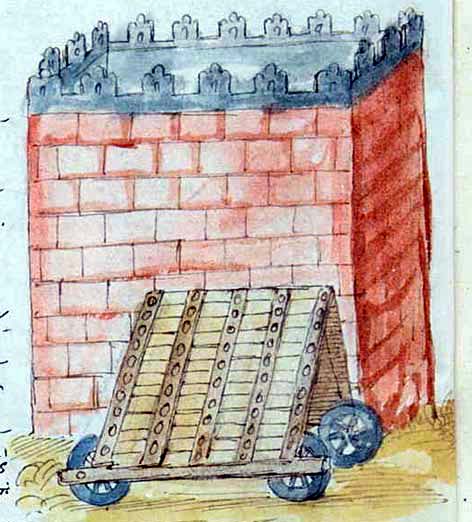 Apollodori: Poliorcetica (Excerpta), detail of folio 26 verso: excavating tortoise |
The rules governing the preparation and conduct of warfare in medieval times relied heavily on these classical manuals of military science, which describe in detail and illustrate the tactics of siegecraft. To blockade a site, units surrounded it to stop entry and exit of troops and supplies. Earth works or palisades might also be constructed. When attacking a site, a major consideration was how to get over the walls. There were three methods: over (using siege towers, mounds or ladders), through (using rams) or under (mining). First, attempts were made to dominate the wall area by missile fire, the main aim of this being to destroy enemy artillery. There were two main types of artillery equipment: bolt-throwers
(ballistae: used for picking off prominent individuals), and
stone-throwers (scorpiones, onagri). Stone throwers could
cause structural damage, but were generally confined to firing at
towers, gates or siege machinery. Artillery might use incendiary
ammunition when firing at gates or equipment. Individual archers could
also use fire arrows with an incredible effect. To gain access to the
walls it was necessary to fill the ditch around a site, so that
equipment could be brought into position next to the walls. Once the
ditch was filled, a siege tower or ram could be brought into position
and used to launch an attack onto the walkway, aided by missile fire from the higher levels of the tower. Simultaneous attacks
with scaling ladders took place. Mining
was another strategy, and sometimes concealed entrances might be used to prevent
counter-mining. Sometimes the tunnel would be fired to collapse a wall
section or tower, then the breach would be assaulted on the surface.
Storming parties usually used a testudo or tortoise as the attack
formation for protection against missiles. |
| A siege tower is a specialized siege engine constructed to protect assailants and the ladders used when approaching the defensive walls of a fortification. The tower was usually rectangular, with four wheels and a height roughly equal to that of the wall; it was sometimes higher to allow archers to stand on the top and fire into the fortification. The tower was made chiefly of wood, but sometimes there were metal components as well. They were both unwieldy to manoeuvre, and slow to assemble, and consequently were usually constructed at the siege site. They were considered a "last resort" to be used only if defences could not be overcome by ladder assault, mining or ramming. Sometimes siege towers themselves incorporated other devices, including artillery, rams, and dropbridges. |
|
| In common with much Byzantine literature, poliorcetica draw heavily on earlier, classical material. Since these were composed before the development of heavy artillery, the poliorcetica are not so much concerned with large machines but rather with describing techniques for bringing men close to fortifications and then ways of undermining them. They also suggest various psychological tricks which might be used to outwit the enemy. Such ancient works on military machines were a source of fascination to the Italians of the late 15th and 16th centuries, not only because of their historic interest, but also as a source for modern inventions to be used in contemporary warfare. The pen and watercolour drawings which are a colourful feature of this manuscript - more especially in the treatises by Athenaeus and Apollodorus - are intended not as mere decoration but as working diagrams to elucidate the text; they include plans of machines in which different parts are identified by different colours for ease of identification. |
|
|
|
The six texts included in our manuscript are:- Athenaei: De Machinis (Athenaeus' Treatise on Engines), Bitonis: De Constructione Bellicarum Machinarum et Catapultarum (Biton's Treatise on the Construction of Warlike Engines and Catapults), Heronis: De Constructione et Mensura Manubalistae (Heron's Treatise on the Construction and Proportions of the Falarica), Heronis Ctesibi: Belopoeica sive Telefactiva (Heron's Treatise on the Manufacture of Missiles), Apollodori: Poliorcetica Excerpta (Extracts from Apollodorus' Poliorcetica), and Philonis Byzantii: Mechanike Syntaxis (Extracts from Philon's Compendium on Mechanics, described by Young and Aitken as Books 4 and 5 of De Telorum Constructione). |
| The treatise on Greek siege machinery attributed to Athenaeus "Mechanicus" is unique among poliorcetica in that it combines general learning and historical survey with new proposals, something which gave the author considerable personal satisfaction, as is evident from his comments below. |
 Athenaei, De Machinis : folio 6 recto, lines 2-7 |
"Everything said in the above has been well grasped by me, with the treatment done precisely in each case; and I have taken a personal pride in enlarging the resources of what is useful for machine-making. For one must not only know the fine inventions of others; rather, since there is agility in the spirit, one must invent something oneself." |
| It has been proposed (Whitehead and Blyth,
2006) that Athenaeus was a Cilician ex-statesman living in Rome in the
20s B.C., a contemporary of the architect-engineer Vitruvius, and that
like Vitruvius, he worked under the patronage of the Emperor Augustus.
Vitruvius devoted Book 10 of his De Architectura to machines, and
Athenaeus wrote his Peri Mechanematon (On Machinery) for Augustus'
nephew and son-in-law. Both texts describe Hellenistic siege machines (i.e
from the period between Alexander and Augustus.) In addition to describing individual siege engines and theorising on tactics, Athenaeus draws on actual instances from history of the use of these machines in order to make various points and elucidate his text. For example, see his description below of developments during the siege of Chios, and the use of the sambuca, a mechanical ladder, called after a type of musical instrument, which it resembled in shape. |
|
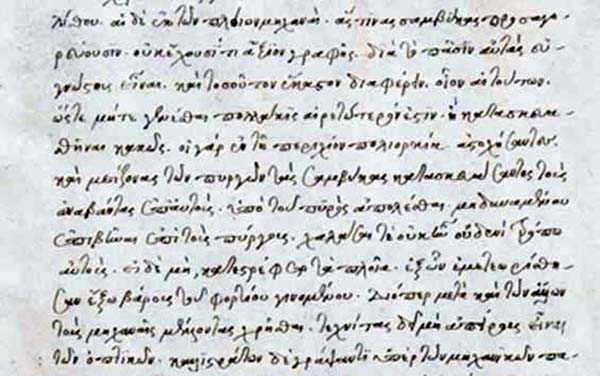 Athenaei, De Machinis : folio 5 recto, lines 5-16 |
"The devices [operated] from ships, which some call sambucas, merit no description because they are well-known to everyone; and I think that each of these is so different that it is often preferable that they should not be made than constructed badly. Witness the aggressors in the siege of Chios: having guessed wrong and built the sambucas larger than the towers, they caused those who went up them to be burned to death, unable as they were to cross onto the towers, and there was no way of lowering the sambucas; otherwise, the ships were likely to capsize as a result of their superstructures, with the weight of the burden outside. Hence, artificers who intend to use the devices must not, along with their other skills, be inexperienced in surveying." |
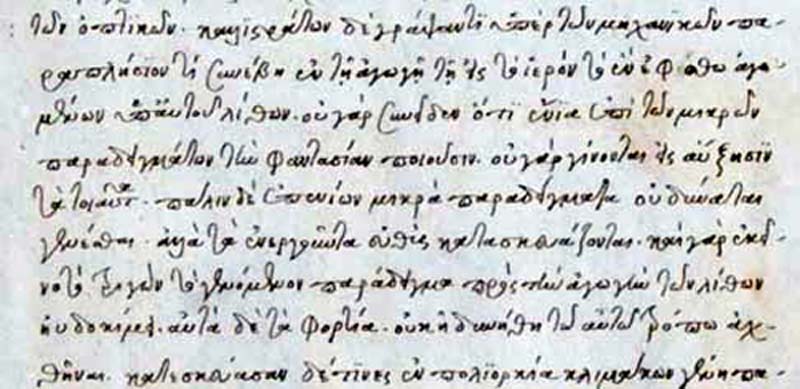 Athenaei, De Machinis: folio 5 recto, lines 16-24 |
| He also describes (see above) how something may sound good in
theory, but is unsuccessful in practice. (Even though, in the case of
Callistratus, the originator of the theory seems to have found fame for
his idea nevertheless!) "Something similar happened to Callistratus, who wrote On Engineering, during his transportation of stones to the temple in Ephesus. He did not grasp, you see, that some things create an illusion when made in small models, because such things do not lend themselves to enlargement; conversely in some cases small models cannot be made, and instead the operational ones are constructed straight away. The fact was that that triangular model he made for the transportation of the stones became famous, but the actual loads were impossible to carry that way." |
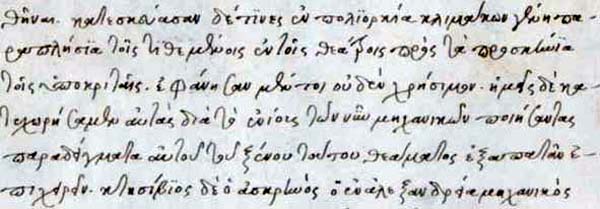 Athenaei, De Machinis folio 5 recto: lines 24-30 |
"Some people during a siege built types of ladders similar to those placed against the stage in theatres for the actors; they turned out, however, to be of no use. But we for our part have put them on record, because of the fact that some present-day engineers attempt deception by making models of precisely this strange spectacle." |
| "When, you see, they plan to take a coastal city, certain
master-builders are in the habit of yoking the machines onto
merchant-ships in calm waters and taking them towards the walls; but
if they are caught unawares by the wind and a wave is nurtured which
swamps the vessels, the machine which has been attached rolls
around, as the vessels are not making the same movement; hence, with
the machines breaking up, boldness is induced in the enemy by the
self-destructive device. One must therefore fix on the platform
attached to the merchant-ships in the middle the so-called little
ape, so that the machine stays upright in any inclination as the as
the billow shakes it; and against the winds [one must] also have the
preparation as a defence. When the ships are nearer the wall: then
is the time to erect machines on them by means of compound pulleys."
(Athenaei,
De Machinis folio 6 recto: Lines 7-19)
|
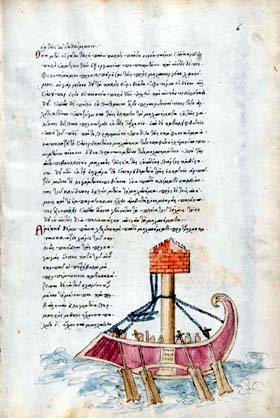 Athenaei, De Machinis: folio 6 recto |
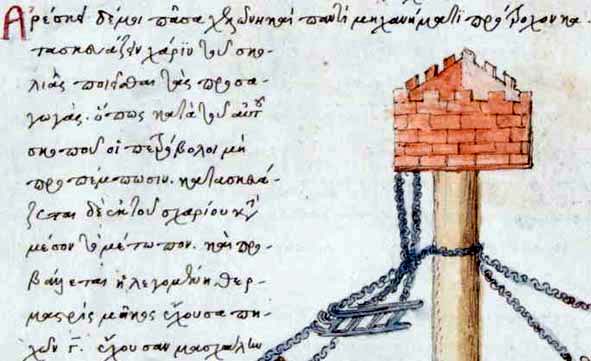 Athenaei, De Machinis: folio 6 recto, lines 20-30 |
"I am in favour of every tortoise and every machine being built with a forewheel to allow its advances to be crooked, so that the stone-throwers cannot always shoot at the same target. Built out from the base in the middle of the front-face and jutting forward is the so-called tongs, three cubits in length, with an armpit." |
|
|
|
| Both texts three and four are attributed to Heron of Alexandria (c10-75 AD). Some
of his ideas derived from the works of Ctesibius (fl. 285-222 BC), a
Greek or Egyptian inventor and mathematician, and probably the first
head of the Museum at Alexandria. None of his work survives but it is
chronicled by Vitruvius, Athenaeus and Philo of Byzantium, as well as
Heron of Alexandria. Heron possibly taught at the Museum at Alexandria as
his work resembles lecture notes on mathematics, physics, pneumatics and
mechanics. A significant number of his works have survived, but his
authorship of some is disputed. Our manuscript consists of two of his
attributed works: the Cheirobalistra (or Manubalistae in Latin) and the
Belopoeica, which describes how to construct engines of war. These are
both similar to works by Biton, Philon and Vitruvius. |
|
|
|
|
| In the mid 10th century A.D. Apollodorus' Poliorcetica was updated and supplemented by an anonymous Byzantine author, conventionally denoted "Heron of Byzantium" (a reference to Heron of Alexandria). An instructional manual, the Parangelmata Poliorcetica was written for the non-specialist; its author re-interprets his sources and adds additional information and explanations. He assumes the Poliorcetica was addressed to Hadrian and describes the battering ram, the largest siege engine in antiquity. |
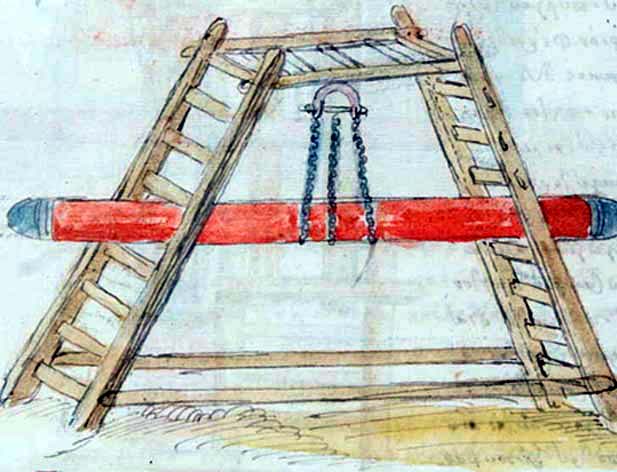 Apollodorus, Poliorcetica (Excerpta): detail of folio 38 verso: ram between ladders |
Rams were used to break down a door or wall. To shield the soldiers from attack they built a covering shed, in which they hung a thick trunk on chains suspended from a beam above. The front was tapered into a blunt point capped with iron. The slow movement forward earned its nickname of "tortoise". The hanging trunk swung back and forth and the front of the trunk moved in and out of the shed like a tortoise's head out of its shell, battering the target. Sometimes the shed was covered with animal pelts or earth to make it fireproof. According to Apollodorus, the shed should be fixed to the ground whilst the ram was being used to prevent both skidding and strain on the axles from the weight of the moving apparatus. This would also increase the strength of the impact on the walls. |
| The manuscript's sixth text is attributed to Philon of Byzantium, who is believed to have been born about 280 B.C. in
Byzantium and to have died around 220 B.C. Although there are few
references to him in literature, he is mentioned by Vitruvius. His major
work was the Mechanike Syntaxis, of which only parts have survived.
Amongst other weapons of siegecraft, he describes the catapult, recently invented by Ctesibius. From this we date Philon's
treatise fairly accurately to around 250 B.C. He describes journeys he
made to Rhodes and to Alexandria to study catapults, and it seems he
may have earned his living advising military rulers. His most
important contribution to mathematics was a method of duplicating the
tube.
|
|
|
|
His style is unusual, the text consisting of many short chapters. The work is not only about the techniques of warfare but also includes advice on the social implications and practicalities of warfare; for example, he argues that those badly injured in attacks and unable to work again should be given pensions, and that widows of those killed should be provided for. He also recommends not only the use of machines but also tactics such as starving a town's inhabitants, bribing accomplices, using poison to kill enemies and using cryptography to deliver messages. |
| This is the only manuscript of this genre in our collections,
but we do have a copy of a 15th century printed edition of the treatise De Re Militari
by Roberto Valturio; this important work on medieval warfare
was, in effect, the handbook of the military leaders of the
Renaissance. It was the first book printed with illustrations of a
scientific or technical character, and these show a wide range of
weapons including battering rams, siege towers, extending ladders and
catapults, and weapons used in marine warfare. Examples of poliorcetica in other libraries include British Library Burney 69. This is a manual of poliorcetics by the 10th century writer known as Hero of Byzantium; dated to around 1545, it is an Italian manuscript written in Greek minuscule scrip and illustrated by numerous drawings. Vaticanus Graecus 1605, a manuscript of the Vatican Library, preserves two mid-10th century treatises by Hero of Byzantium. The first is an adaptation of the Poliorcetica of Apollodorus of Damascus, which simplifies for non-engineers the descriptions of siege engines. |
|
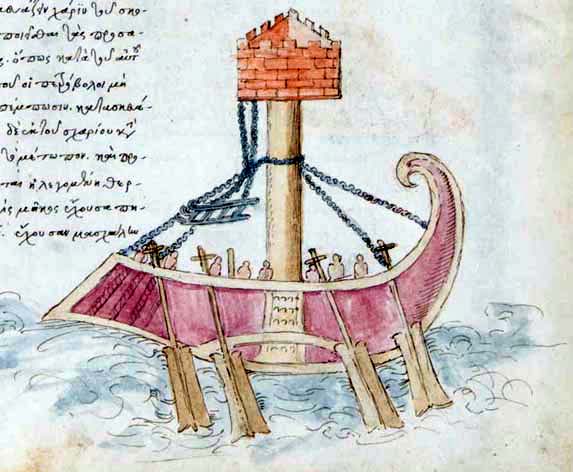 Athenaei, De Machinis: folio 6 recto: detail of tower on ship. |
Whilst it is not possible to date our
volume with any accuracy, it is written in a humanistic style Greek hand on a glazed 16th century
paper with watermarks of a double-tailed mermaid surmounted by a
star, similar to those illustrated in Briquet, numbers 13899 and 13896,
both originating in Naples. It is evenly written in one hand throughout, in single columns of
about thirty lines. The binding consists of pasteboards covered
in vellum with gilt edges, goffered and with the title in ink:
MECHANICI VETERES. The identity of the scribe who produced the manuscript is not known but it was ascribed by I. C. Cunningham in his Greek Manuscripts of Scotland (Edinburgh, 1982) to Camillus Venetus (Camillo Zanetti), a prolific 16th century scribe based in Venice who worked principally for the Paduan savant Gian Vincenzo Pinelli (1536-1601). |
| It is easy to overlook the considerable contribution to the cultural and intellectual life of Renaissance Europe which was made by such scribes who assiduously copied manuscripts of the Greek texts, and then who later assisted in the preparation of these texts for printing - thus facilitating the spread of a knowledge of classical Greek in Italy. Most of them are only known from the signatures or colophons appended to the works they copied. One of the most prolific was John Rhossos, a Cretan priest, who spent about fifty years copying books for wealthy patrons. Many of these scribes may have originally come to Italy as refugees in the wake of Turkish incursions into the Greek-speaking Byzantine east, and copied manuscripts as a means of earning their living. |
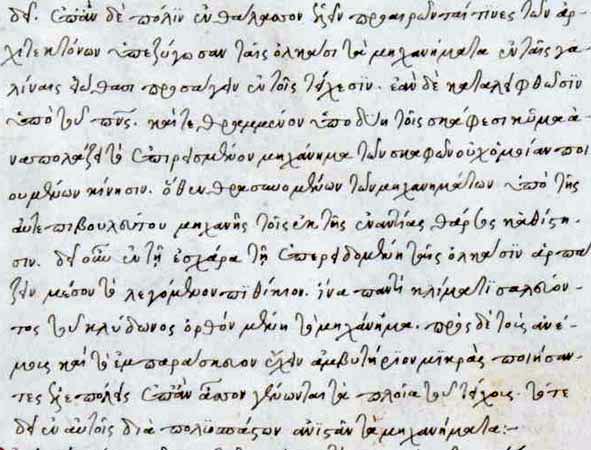 Athenaei, De Machinis: folio 6 recto: Lines 7-19 |
|
|
|
Charles Moise Briquet Les filigranes:dictionnaire historique des marques du papier Leipzig 1923 Level 11 Main Lib Bibliog qB103 1923-B
Pamela Porter Medieval warfare in manuscripts London: British Library c2000 Level 11 Main Lib Bibliog B162:20 2000-P
Denis F. Sullivan (ed.) Siegecraft: two tenth-century instructional manuals Washington, D.C.: Dumbarton Oaks Research Library and Collection c2000 Level 8 Main Lib History NG130 SIE
Duncan B. Campbell Siege warfare in the Roman world 146 BC- AD 378 Oxford: Osprey Publishing, 2005 Level 10 Main Lib Classics RG810 CAM2
Hugh Elton Warfare in Roman Europe AD 350-425 Oxford: Clarendon Press; New York: Oxford University Press, 1996 Level 10 Main Lib Classics RG810 ELT
Eric McGeer Sowing the dragon's teeth: Byzantine warfare in the tenth century Washington D.C.: Dumbarton Oaks Research Library and Collection, c1995 Level 8 Main Lib History NG130 MACGE
University of Glasgow. Library. The glory of the page: medieval & renaissance illuminated manuscripts from Glasgow University Library Introduction & catalogue by Nigel Thorp. London:1987 Level 11 Main Lib Bibliog B162 1987-U & Sp Coll Hunterian Add. f59
C. Wesher Poliorcetique des Grecs Paris: Imprimerie Imperiale, 1867 Level 10 Main Lib Classics qF99.M7 WES
Article on Philon from University of St Andrews website http://www-groups.dcs.st-and.ac.uk/~history/Biographies/Philon.html [page accessed 1 February 2008]
Article on Heron from University of St Andrews website http://www-groups.dcs.st-and.ac.uk/~history/Biographies/Heron.html [page accessed 1 February 2008]
Article on Apollodorus of Damascus from Infoplease.com http://www.infoplease.com/ce6/people/A0804366.html [page accessed 1 February 2008]
Article on Apollodorus of Damascus from University of Chicago website http://penelope.uchicago.edu/~grout/encyclopaedia_romana/imperialfora/trajan/apollodorus.html [page accessed on 1 February 2008]
Article on Byzantines in Renaissance Italy from The ORB: On line Reference Book for Medieval Studies http://www.the-orb.net/encyclop/late/laterbyz/harris-ren.html [page accessed 19/6/08]
British Library Catalogue of Illuminated Manuscripts http://www.bl.uk/catalogues/illuminatedmanuscripts/welcome.htm
Vatican Library http://bav.vatican.va/en/v_home_bav/home_bav.shtml
Return to main Special Collections
Exhibition Page
Go to previous
Books of the Month
Fiona M.Neale August 2008